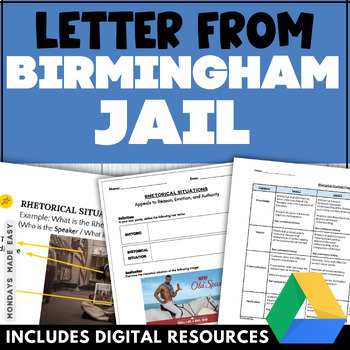Letter from Birmingham Jail Analysis Unit - Martin Luther King Jr. Day Bundle
- Zip
- Google Apps™

Products in this Bundle (2)
Bonus
Description
Explore “Letter from Birmingham Jail” on Martin Luther King Jr. Day using these bell ringer reading questions and rhetorical analysis activities. Great for AP Language and Composition and senior English classes on MLK Day or any day of the year! Includes digital worksheets for Google Classroom®.
⚡︎⚡︎⚡︎ Save over 10% with the bundled discount! ⚡︎⚡︎⚡︎
Included with this “Letter from Birmingham Jail” Analysis Unit for Martin Luther King Jr. Day:
✏️ 10 Bell Ringer Quiz Questions for “Letter from Birmingham Jail” - Digital & Print
✏️ Rhetorical Analysis Slideshow Lesson - Google Slides®, Microsoft PowerPoint®, and PDF
- Explore Ethos, Logos, Pathos, Aristotle’s Rhetorical Triangle, the SOAPSTone Acronym, and the Rogerian Argument
✏️ Rhetorical Analysis Guided Note - Digital & Print
✏️ Rogerian Argument Graphic Organizer - Digital & Print
- Apply the Rogerian Argument outline to “Letter from Birmingham Jail” by Martin Luther King Jr.
✏️ Detailed Answer Keys
✏️ Rhetorical Analysis Assignment for "Letter from Birmingham Jail"
✏️ Editable and Ready-to-Print Rubric
✏️ Teacher Instructions for using this resource
Resources included in this Bundle for Martin Luther King Jr.’s “Letter from Birmingham Jail”:
1. “Letter from Birmingham Jail” Bell Ringer Quizzes
Looking for an activity to teach on Martin Luther King Jr. Day? These comprehension questions will challenge students to read “Letter from Birmingham Jail” closely. This activity is suitable for MLK Day, or any day of the year!
Martin Luther King Jr's "Letter From Birmingham Jail" is a powerful example of argumentative writing to examine the civil rights movement. Assess students' comprehension, understanding, and reading completion using these bell ringer reading quizzes!
These bell ringer quizzes include ten close reading questions that evaluate students' reading comprehension. The bell ringer quizzes are divided into two sets. The first set is for assessing paragraphs 1-21; the second set assesses paragraphs 22-40. This is to allow differentiated instruction in case you wish for your students to complete their reading homework for "Letter from Birmingham Jail" in two periods.
For further differentiation, you can also use these reading quizzes as guided reading questions while your students are reading "Letter from Birmingham Jail." This is a great option for students who require extra support while exploring Martin Luther King Jr.'s complex essay.
To consolidate these reading questions, a comprehensive answer key has been provided.
2. “Letter from Birmingham Jail” Rhetorical Analysis Lesson and Worksheets
Martin Luther King Jr's "Letter From Birmingham Jail" is a great text to practice rhetorical analysis and study the Rogerian Argument outline. This resource includes a Rhetorical Analysis Slideshow Lesson for Microsoft PowerPoint® and Google Slides® with accompanying guided note worksheets.
This slideshow will guide your students through a lesson on rhetorical situations, including Aristotle's Rhetorical Triangle (ethos, logos, and pathos). Students will also learn about the SOAPSTone acronym for analyzing any text. The slideshow lesson includes a link to a video that your students will use to practice analyzing using the SOAPSTone acronym together.
Students will also be introduced to the structure of the Rogerian Argument. To practice, they will apply this structure to Martin Luther King Jr's “Letter for Birmingham Jail” using the Rogerian Argument Graphic Organizer.
To consolidate these activities, detailed answer keys have also been provided.
3. ✨ BONUS: Rhetorical Analysis Assignment for "Letter from Birmingham Jail" with Editable Rubric
To consolidate these lessons, worksheets, and activities, students can complete a rhetorical analysis presentation! This bonus file includes both editable and ready-to-print assignment instructions and a 4-level rubric. Download the preview for this bundle to learn more!
⭒ For classrooms utilizing Google Classroom® ⭒
To access the digital version of these worksheets and activities, simply follow the instructions within the resource to copy the files directly to your Google Drive®.
☞ See what others are saying!
⭐️⭐️⭐️⭐️⭐️
Extremely Satisfied
A very valuable resource for my students learning how to analyze rhetorical choices. Thank you for this great resource.” - Charles Tarlton
⭐️⭐️⭐️⭐️⭐️
Extremely Satisfied
“I love teaching this text, but it can get routine year after year. This resource helped change things up a bit. Thanks!” - Alice B.
⭐️⭐️⭐️⭐️⭐️
Extremely Satisfied
“I used this with my AP Language and Composition class. This was engaging and challenging. It was a great way to focus on the passage.” - Paige B.
✨ Kindly note that due to copyright restrictions, these resources are not editable. This is a common practice within the TPT marketplace in order to protect the clip artists and software providers that have authorized their intellectual property for the development of this resource.
You might also be interested in Mondays Made Easy's Resources for AP Language and Composition.
⭐ Customer Tip! ⭐
Want FREE CREDIT to go towards purchases? Make sure to offer feedback for your downloads! Follow these instructions below:
- Go to your "My Purchases" page to find a "Provide Feedback" button next to each download.
- Follow this link to offer a quick rating and leave a short comment for the product. Each time you give feedback, TPT gives you feedback credits that you use to lower the cost of your future purchases!
- Your feedback is important to me as it helps me to continually improve my products and ensure they are meeting your needs!
Follow me! Be the first to know about product launches, sales, discounts, and free giveaways:
➾ The Blog
For questions, collaborations, or other concerns:
✉ Contact me: hello@mondaysmadeeasy.com
Access my Free Resource Library!
Mondays Made Easy is committed to the continual improvement of resources to meet the current needs of teachers. This product was last updated on December 8, 2023.





